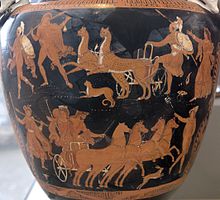Rape of Persephone
The Rape of Persephone, or Abduction of Persephone, is a classical mythological subject in Western art, depicting the abduction of Persephone by Hades. In this context, the word Rape refers to the traditional translation of the Latin raptus ('seized' or 'carried off') which refers to bride kidnapping rather than the potential ensuing sexual violence.[1]
Mythological background

Persephone is the daughter of Zeus and Demeter. Hades wished to make her his wife, so he got permission from her father Zeus and help from Gaia to abduct her into the Underworld. When Persephone was picking flowers in a field, Hades emerged on his chariot from a crack on the earth, and carried off the unwilling Persephone; only Hecate and Helios witnessed the abduction, and later told Demeter.[2]
Paintings
Allori
This painting on a large wooden panel is entitled The Abduction of Proserpine. It was painted in 1570, and spent most of its life residing in the Villa Salviati after being commissioned by the Salviati family.[3]
Rembrandt
Painted in around 1631, The Abduction of Proserpina has largely been attributed to Rembrandt. Although the painting remains unsigned, the style and composition is highly indicative of being a legitimate Rembrandt. It is currently displayed as a part of Gemäldegalerie, Berlin, permanent exhibit.[4]
Rubens

Created in 1636 and 1637, Peter Paul Rubens depicted the abduction of Persephone in a piece entitled The Rape of Proserpine. The piece was intended to decorate the lost Torre de la Parada, and as such was owned by the Spanish Royal family.[5]
This was copied later in the 17th century by Juan Bautista Martínez del Mazo in oil on canvas under the name of El Rapto de Proserpina, and later again reproduced by the Real Establecimiento Litográfico de Madrid in the 19th century for the purpose of printing and distribution.[citation needed]
Giordano
As part of a set of oil studies intended to be used for painting the ceiling frescoes in the Palazzo Medici Riccardi in Florence, the Mythological Scene with the Rape of Proserpine was created with the intention of being presented to Marquess Francesco Riccardi for approval before being painted in the palace. Currently, ten of the twelve oil studies created between 1682 and 1685 reside in the National Gallery.[6]
Other Paintings
- The Rape of Persephone, a painting in the Macedonian Tomb I in Vergina (Aegae),[7] dating from the mid 4th century BC. This in situ mural is mostly indistinguishable, other than the figures of Hades and Persephone themselves on a chariot.[8]
This list is by no means exhaustive, but seeks to highlight some prominent examples of the myth in Western paintings.
Sculpture

Examples include:
- The Rape of Persephone from the Roman villa of Chiragan, in Musée Saint-Raymond, Toulouse
- The Rape of Persephone, by Pinturicchio, in the vault of the Piccolomini Library in the Duomo, Siena
- The Rape of Proserpina by the Italian artist Gian Lorenzo Bernini, a large Baroque marble sculptural group, executed between 1621 and 1622
References
- ^ Jones, Brandon (January 2019). "The Poetics of Legalism: Ovid and Claudian on the Rape of Proserpina". Arethusa. 52: 71–104. doi:10.1353/are.2019.0002. S2CID 202374163.
- ^ Homeric Hymn to Demeter 1–86
- ^ Alessandro Allori (1570). The Abduction of Proserpine (Oil on panel).
- ^ Bryun, J; Haak, B.; Levie, S.H.; Van Thiel, P.J.J.; Van De Wetering, E. (1982). "The abduction of Proserpina". A Corpus of Rembrandt Paintings. Vol. 1. p. 365.
- ^ Peter Paul Rubens (1636–1637). The Rape of Proserpine (Oil on canvas).
- ^ Luca Giordano. Mythological Scene with the Rape of Proserpine (Ceiling fresco).
- ^ Erksine, A.; et al., eds. (2017). "THE ROYAL COURT IN ANCIENT MACEDONIA: THE EVIDENCE FOR ROYAL TOMBS". The Hellenistic Court. Bristol. p. 410.
{{cite book}}: CS1 maint: location missing publisher (link) - ^ Stefanakis, Μ. Ι.; Vlavogilakis, Α. (15 February 2014). "Reproducing the Wall Painting of the Abduction of Persephone (Vergina-Macedonia): Conditions and Restrictions for a Successful Archaeological Experiment". Exarc Journal (EXARC Journal Issue 2014/1).
External links
 Media related to Rape of Persephone at Wikimedia Commons
Media related to Rape of Persephone at Wikimedia Commons
